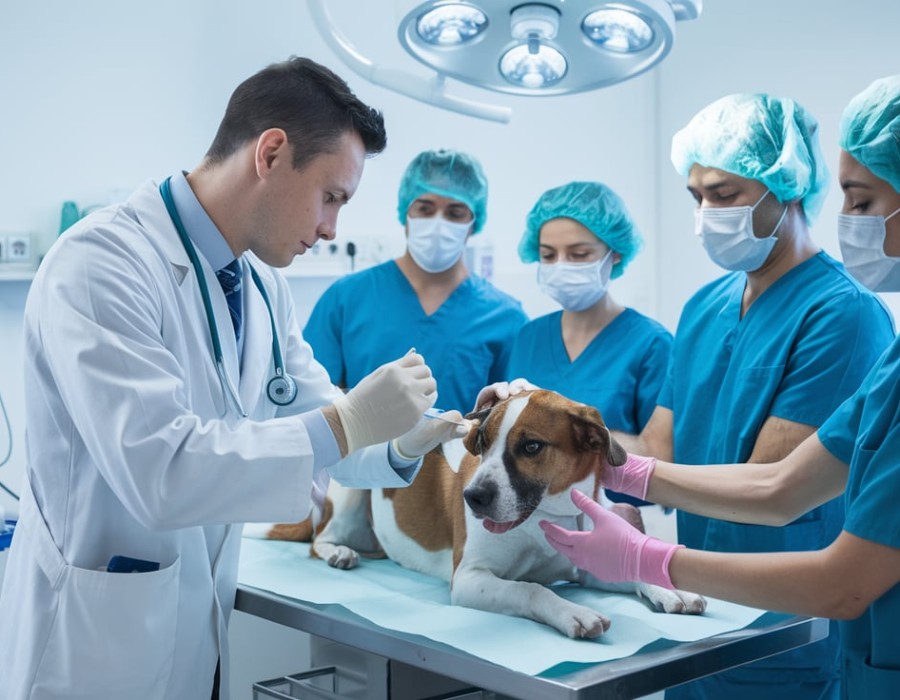Understanding the Need for Sedation in Dogs
Sedation is a critical aspect of veterinary surgery, allowing dogs to undergo procedures without distress or discomfort. Dogs, like humans, can experience anxiety and fear when faced with surgery. Sedatives help create a calm and controlled environment, ensuring the safety of both the animal and the veterinary team. The use of sedatives is not only to ease anxiety but also to facilitate the administration of anesthesia, manage pain, and allow for more straightforward surgical procedures.
Types of Sedatives Used in Veterinary Medicine
Veterinarians utilize various sedatives, each with unique properties and effects. Common sedative classes include:
- Benzodiazepines: These drugs, such as diazepam (Valium) and midazolam, provide anxiolytic effects, muscle relaxation, and amnesia. They are often used in combination with other sedatives or anesthetics.
- Alpha-2 Agonists: Drugs like dexmedetomidine (Dexdomitor) are widely used for their potent sedative effects and analgesic properties. They help decrease heart rate and blood pressure, making them effective in certain surgical situations.
- Opioids: Medications such as morphine and fentanyl are primarily used for pain management but can also induce sedation, particularly when used in conjunction with other sedatives.
- Barbiturates: These agents, including thiopental, are used less frequently today due to their potential side effects but can induce rapid sedation for quick procedures.
The Process of Sedating a Dog
The sedation process begins with a thorough assessment of the dog's health and medical history. This includes understanding any pre-existing conditions, allergies, and medications the dog may currently be taking. Based on this information, veterinarians will select the most appropriate sedative, considering the dog’s size, age, and temperament.
Once the sedative is chosen, it can be administered either orally, intramuscularly, or intravenously. The method of administration may depend on the specific procedure and the desired speed of sedation. Monitoring during this process is crucial to ensure the dog responds appropriately to the sedative.
Pre-Anesthetic Considerations
Before sedation, veterinarians often conduct pre-anesthetic tests, which may include blood tests, to evaluate the dog's overall health. This helps identify any underlying health issues that may affect how the dog metabolizes sedatives or anesthetics. Pre-anesthetic testing is particularly important for older dogs or those with known health concerns, as it allows for a tailored approach to sedation and anesthesia.
Monitoring Sedated Dogs During Surgery
During the surgical procedure, the veterinary team closely monitors the dog’s vital signs, including heart rate, respiratory rate, and oxygen saturation levels. Advanced monitoring equipment is often used to provide real-time data, allowing for immediate intervention if any abnormalities arise. The combination of sedatives and anesthetics requires vigilance to ensure the dog remains stable and comfortable throughout the surgery.
Recovery from Sedation
Post-surgery, dogs may experience grogginess as the sedative wears off. Recovery times can vary depending on the type of sedative used and the individual dog's response. It is essential for pet owners to provide a quiet, comfortable space for their dogs to rest as they regain full consciousness. Veterinarians will typically provide instructions on monitoring for any adverse reactions during recovery, such as excessive drooling or disorientation.
Risks and Side Effects of Sedation
While sedation is generally safe, there are risks and potential side effects associated with the use of sedatives. Some dogs may experience:
- Hypotension: Low blood pressure can occur, particularly with certain sedatives.
- Bradycardia: A slowed heart rate is a common effect of alpha-2 agonists and requires careful monitoring.
- Allergic Reactions: As with any medication, some dogs may have an allergic reaction to sedatives.
Understanding these risks allows veterinarians to take necessary precautions and manage any adverse effects promptly.
Alternatives to Sedation
In some cases, alternative methods to manage anxiety and pain may be considered. Techniques such as behavioral training and desensitization can help dogs feel more comfortable with veterinary visits and procedures. Additionally, certain natural supplements and pheromone products may be used to reduce anxiety. However, these alternatives may not be suitable for all dogs or all types of surgery.
The Importance of Veterinarian Expertise
Sedation and anesthesia in dogs require a high level of expertise. Veterinarians must be knowledgeable about the pharmacology of sedatives, the specific needs of each dog, and the potential interactions between different medications. This expertise is crucial in selecting the appropriate sedative and ensuring the safety and comfort of the dog throughout the surgical process.
Conclusion: Ensuring Safe and Effective Sedation for Canine Surgery
The use of sedatives in veterinary medicine is vital for facilitating safe surgical procedures. By understanding the types of sedatives available, the sedation process, and the importance of monitoring, pet owners can feel confident in the care their dogs receive. With the right combination of expertise, preparation, and monitoring, veterinary teams can ensure that dogs undergo surgery with minimal stress and optimal outcomes. Keeping lines of communication open between pet owners and veterinarians is essential for making informed decisions about sedation and overall pet care.





Comments